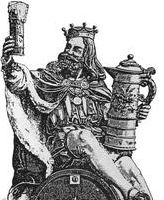Gambrinus
Gambrinus (/ɡæmˈbraɪnəs/ gam-BRY-nəs) is a legendary European culture hero celebrated as an icon of beer, brewing, joviality, and joie de vivre. Traditional songs, poems, and stories describe him as a king, duke, or count of Flanders and Brabant.[1][2] Typical representations in the visual arts depict him as a rotund, bearded duke or king, holding a tankard or mug, and sometimes with a kegnearby.
Gambrinus is sometimes erroneously called a patron saint,[3] but he is neither a saint nor a tutelary deity. It is possible his persona was conflated with traditional medieval saints associated with beermaking, like Arnold of Soissons. In one legendary tradition, he is beer's inventor or envoy. Although legend attributes to him no special powers to bless brews or to make crops grow, tellers of old tall tales are happy to adapt them to fit Gambrinus. Gambrinus stories use folklore motifs common to European folktales, such as the trial by ordeal. Some imagine Gambrinus as a man who has an enormous capacity for drinking beer.[3]
Among the personages theorised to be the basis for the Gambrinus character are the ancient king Gambrivius (or Gampar), John the Fearless (1371–1419) and John I, Duke of Brabant (c. 1252–1294).
The source of the legend of Gambrinus is uncertain. An early written account, by German historian Johannes Aventinus (1477–1534), identifies Gambrinus with Gambrivius, a mythical Germanic king about whom little is known. Two other men purported to have inspired the creation of Gambrinus are John I, Duke of Brabant, and John the Fearless, Duke of Burgundy.
In his magnum opus Annals of Bavaria, German historian Johannes Aventinus wrote that Gambrinus is based on a mythical Germanic king called Gambrivius, or Gampar, who, Aventinus says, learned brewing from Osiris and Isis. In 1517, William IV, Duke of Bavaria had made Aventinus the official historiographer of his dukedom. Aventinus finished composing the history in 1523; the work that he compiled, Annals of Bavaria, extends beyond Bavaria, drawing on numerous ancient and medieval sources. However, it is also a work that blends history with myth and legend.
European anecdote credits Gambrinus with the invention of beer. Aventinus attempted to reconcile this account with much older stories attributing its origin to Osiris' agricultural teachings.[4][5] In Aventinus' chronicle, Gambrivius was the paramour of Osiris' wife and sister, Isis. It was by this association, he says, that Gambrivius learned the science of brewing (cf. myths of the theft of fire).[6]



.jpg/440px-Henri_Leys_-_John_I,_Duke_of_Brabant_(detail).jpg)
